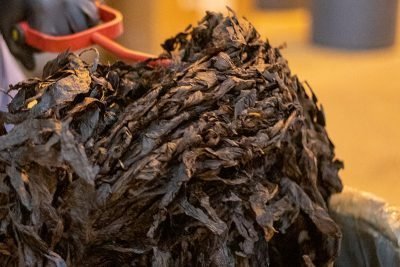All You Need to Know About Perique Tobacco: The Best Tobacco in the World

Perique Tobacco Leaf
Unique tobacco with a long history grows deep in St. James Parish, between the levee and the cane fields. The tobacco, known as perique, is exclusively found in St. James Parish and is one of the world’s rarest commercially farmed tobaccos. Because of cracks in the river levees that have enhanced the silt in the soil throughout the years, perique grows solely in St. James Parish.
Today, there are only approximately 25 perique producers in St. James Parish, which is a modest number in principle but a welcome one given that tobacco was once on the point of extinction.

Brief History of the Perique Tobacco
More than 1,000 years ago, the Choctaws and Chickasaws of Louisiana were known to ferment tobacco leaves in hollowed-out tree trunks. They would place the tobacco leaves in the tree trunks, then cover them with huge stones to begin the fermenting process. This method was picked up by Louisianan immigrants in the 18th or 19th century and refined.
In the early 1800s, Pierre Chenet, an Acadian settler in the region, altered the method and started utilizing wooden boxes for fermentation.
In the early 1900s, there were three perique processors: the Roussels, who industrialized perique by fermenting it in whiskey barrels before ceasing production in 1950; the Guglielmos, who went out of business in the late 1970s; and the Poches, who began in 1917. Perique’s decline was caused by labor-intensive harvesting.
According to the Tobacco Institute, perique has been exported out of New Orleans for over 250 years and is regarded as one of America’s original export crops.
Type of Tobacco Leaf used in Fermentation of Perique Tobacco
Perique tobacco is created by partially air-curing the leaf of a Red Burley (USDA Type 72) and then undergoing a high-pressure anaerobic fermentation procedure. Genuine Perique grows well only in St. James’ Parish, a narrow wedge-shaped stretch of ground west of New Orleans. The finest and only current site for growing Red Burley for Perique inside St. James’ Parish is a very small area called Grande Point Ridge, near Paulina, LA, on dark alluvial soil.
Perique is still made in the same way that it was introduced commercially in the 1820s by Pierre Chenet, who watched Chocktaw Indians smoking tobacco that had been fermented under tree stumps and a lever. The tobacco is picked in late June and air-dried for a shorter period than regular Burley.
After about three weeks of air drying, the major veins (or midribs) are cut by hand, and the leaves are wrapped into ‘torquettes,’ or 1-pound tight bundles (450 g). These are pressed under extreme pressure in big oak whiskey barrels, with the ‘juices’ gathered as they leak out of the top of the press.
Over a year, the torquettes are twisted and returned to the press (along with the “juices”) many times, fermenting “anaerobically,” or without air. The whole procedure takes at least a year and is very labor demanding when compared to curing other tobacco strains. This, along with the restricted crop supply, makes Perique scarce and costly.

How the Perique is used in Vaping
Perique Tobacco users love the new electronic cigarettes or vapes as a tool for reducing cigarette intake and hazardous exposure associated with traditional tobacco smoking. Nicotine (extracted from Perique), flavorings, and other chemicals are heated in the vapes to produce an aerosol that you inhale.
Vaping devices for the Perique come in a variety of shapes, sizes, and colors. Devices emit an aerosol byproduct as a result of heating a liquid, which may include flavorings and other substances that make vaping seem less unpleasant than smoking.
This liquid administers nicotine, marijuana, or other medications to the user via a mouthpiece that is breathed into the lungs and subsequently ejected through the mouth or nose. Perique tobacco has the richest flavor of any pipe tobacco and is regarded by some to be the truffle of pipe tobacco.
Because of its strong flavor, it is seldom used alone but rather combined with milder kinds, to provide spice and intensity to the mixture.

